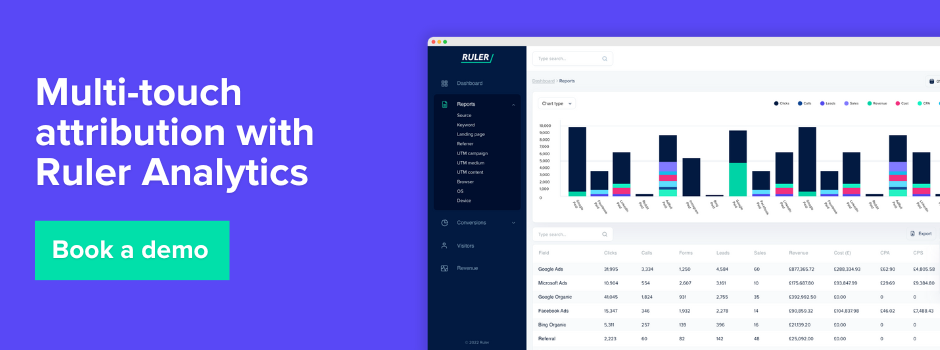Multi-touch attribution is crucial for modern marketing teams. We discuss what multi-touch attribution is, the key benefits, and how you can overcome the challenges associated with it.
Customer journeys were once linear and more predictable.
Customers were limited to a few touchpoints, such as Google Ads and direct mail. This made it easier to track their progress and identify which marketing channels were most effective.
Now, customer journeys are more complex and elongated than ever before.
They can last for months and often involve multiple channels and touchpoints.
It’s hard to tell which touchpoints were most responsible for a conversion as there are so many to consider.
Thankfully, multi-touch attribution can provide marketers with insights into which marketing touchpoints are most effective.
But with the end of third party cookies and the rise of walled gardens, what does the future of multi-touch attribution look like?
Let’s dive in to find out. Here’s what you’ll learn:
💡 TL;DR
– Multi-touch attribution gives credit to each marketing touchpoint that influences a customer’s conversion, instead of just the first or last touchpoint.
– Single-touch attribution gives credit for a conversion to a single touchpoint, while multi-touch attribution distributes credit across multiple touchpoints.
– The most common MTA models are linear, time decay, position-based, and data-driven models, but marketers can create custom models to meet their specific needs.
– Here are the three steps you can use to get started with multi-touch marketing attribution: Capture your marketing data, store your data in a single location and visualise you data.
– Multi-touch attribution has become less effective due to several factors, including the launch of Apple’s iOS 14.5 update and the death of third party cookies.
– While multi-touch attribution offers valuable insights, its mounting limitations have made alternative approaches like marketing mix modelling more appealing.
– To get a more complete and accurate picture of how their marketing campaigns are performing, modern marketers are combining MTA and MMM data with self-reported data.
Multi-touch attribution (also referred to as multi-channel attribution) is a method of judging marketing channel success by analysing each marketing touchpoint that leads to a conversion or closed-won deal.
Before multi-touch attribution, marketers used single-touch attribution, such as last click, which only credited one marketing channel for a conversion.
For example, if a customer read a blog post and then converted, the blog post would have received 100% credit for the conversion, even though other channels may have influenced the customer’s decision along the way.
MTA, on the other hand, gives credit to all of the channels that a customer interacted with before converting. This allows marketers to see the complete customer journey and identify their most effective channels.
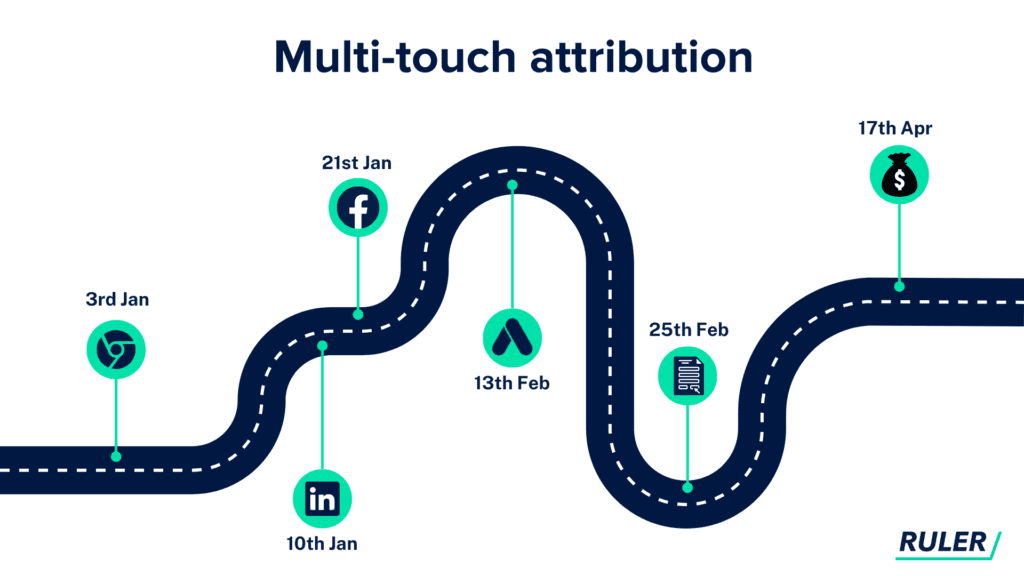
According to a recent study, 75% of companies now use MTA to measure marketing performance.
If you’re using single-touch attribution, you might be wondering if it’s worth switching to multi-touch attribution.
Single-touch attribution and multi-touch attribution are two different methods used to attribute credit for conversions or sales to various touchpoints in a customer’s journey. Let’s explore how they operate, their advantages, and limitations.
| Model | Description | Example | Pros | Cons |
| Single-touch attribution | Single-touch attribution gives credit for a conversion to a single touchpoint, typically the last interaction an individual had before converting into a lead or sale. | First-click attribution: Credits the first touchpoint. Last-click attribution: credits the final touchpoint. | Easy to implement and understand. Clear accountability by pinpointing the touchpoint that led to the conversion. | Ignores the contribution of other touchpoints. Doesn’t reflect the complex customer journey. Over-emphasis the role of direct and immediate touchpoints, such as search. |
| Multi-touch attribution | Multi-touch attribution models distribute credit across multiple touchpoints in the customer journey. | Rules-based attribution: Uses a set of predetermined rules to assign credit for conversions to different marketing touchpoints. Algorithmic attribution: uses machine learning to credit the most influential touchpoints; includes Markov chains. | Distributes credit more evenly. Provides a more complete picture of the customer journey. Helps in optimising marketing strategies and budget allocation. | More challenging to implement and interpret. Requires more data and analytics capabilities. |
The choice between the single-touch and multi-touch attribution depends on the specific goals of a business and the data available for analysis.
Most marketers consider the following multi-touch attribution models the most reliable for tracking marketing effectiveness across multiple marketing touchpoints:
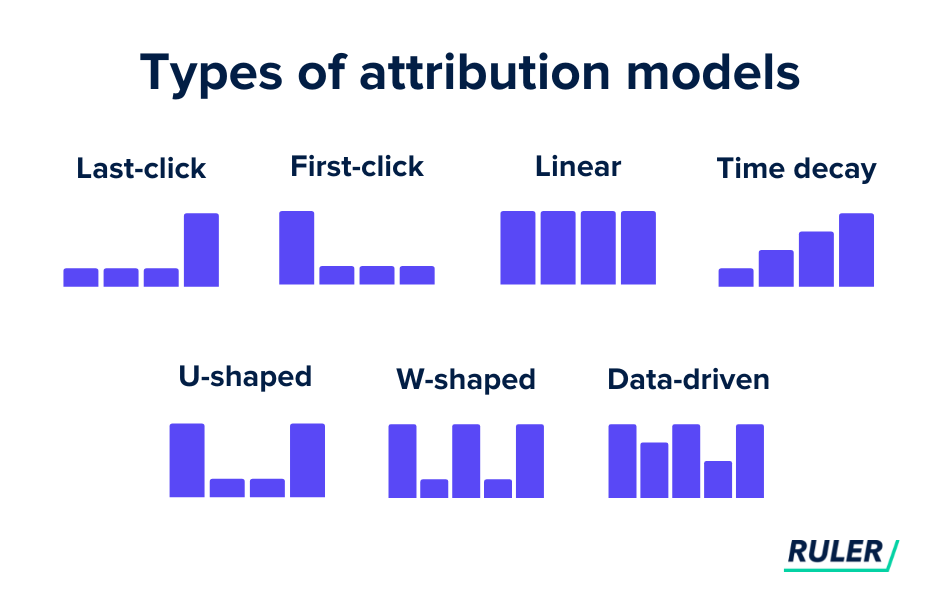
What attribution model you choose should depend on what you’re trying to measure, and the resources you have available. The following table provides the best and worst case scenarios for each model:
| Model | When to use: | When NOT to use: |
| Linear | When customer journeys are short and simple, or when all marketing channels are equally important. | When customer journeys are complex or involve a variety of channels with varying levels of influence. |
| Time-decay | When campaigns are time-bound, such as seasonal promotions, or when it is critical to track interactions that occur closer to the conversion. | When measuring the effectiveness of awareness campaigns and need to identify the early touchpoints that lead to conversions. |
| U-shaped | When highlighting the assisting and converting touchpoints in the customer journey. | When differentiating between various middle touchpoints’ roles and contributions in the conversion process. |
| W-shaped | When considering the first interaction with your brand, the point at which someone becomes a lead, and the point at which a lead becomes a qualified opportunity, with clearly defined stages for each. | When lead creation and opportunity stages aren’t clearly defined or mapped out. |
| Full-path | When you want to understand the complete user experience, from the first-touch point to close. | When you have limited data or incomplete user journey tracking. |
| Data-driven | When you have a large amount of high-quality data and want machine learning to develop an optimal credit scoring model. | When you need transparency and interpretability in attribution. When you have limited data or low data quality. |
| Custom | When you want to reflect the unique characteristics of your industry or marketing strategy. | When you lack the expertise to define custom rules. |
If you want to use multi-touch attribution, you’ll need to ensure your tools and processes are set up to capture the right data, and display it in a way that you can understand.
Here are the three steps you can use to get started with multi-touch marketing attribution.
To truly harness the power of multi-touch attribution, you need to focus on collecting and collating individual data.
Tracking visitors individually allows you to monitor and measure interactions across the customer journey and better attribute credit to specific touchpoints.
There are three ways you can collect individual data, which are often used in tandem.
1. Implement javascript tracking. This is the baseline tracking method for multi-touch attribution. When users land on the website, that code is triggered and tracks their movement and actions from page to page. Your paid media, organic traffic, social and email campaigns will likely all direct to your website in some way, so integrated tracking is the cornerstone of multi-attribution tracking.
2. Utilise UTM parameters and hidden fields. UTM parameters can be appended to your links to track conversions to specific campaigns, sources, and tactics. You can also capture marketing source data of your leads in your sales tracking system by embedding hidden fields in your forms. However, keep in mind that you only get information on leads who have clicked on a UTM click, so you probably won’t get much attribution information for organic channels like organic search, social, and referrals.
3. Invest in 3rd party attribution software. You can use attribution tools with various methods and algorithms to assign credit for conversions and other business outcomes to different marketing touchpoints, such as ad campaigns, email marketing, and social media.
We use our own tool Ruler to track the customer journey at the visitor level using first-party data. It captures the marketing source from each session, page views, UTM variables, Click IDs, and Cookie IDs.
When an anonymous visitor fills out a form, makes a phone call or initiates a live chat query, Ruler will send all of the data it’s captured about this lead to our CRM.
In the CRM, this lead is enriched with Ruler’s attribution data. Once this lead converts into a deal or sale, the customer’s information, such as the revenue amount and marketing data, is sent back to the Ruler database.
In Ruler, we can switch between different attribution models to attribute revenue to marketing touchpoints and interactions in a way that makes sense for us.
Once you start collecting information on your conversions, you need to ensure the data is stored in one place along with the originating marketing source data (e.g. ad, campaign, landing page).
This will allow you to effectively manage every interaction along the path to purchase.
Many organisations opt for a customer relationship management system (CRM) as it allows stakeholders instant access to key information about opportunities and revenue.
Also, most CRMs provide the ability to customise fields, which is key when it comes to tracking lead source and marketing variables.
For example, the screenshot below shows a lead in our CRM with attribution data from Ruler.
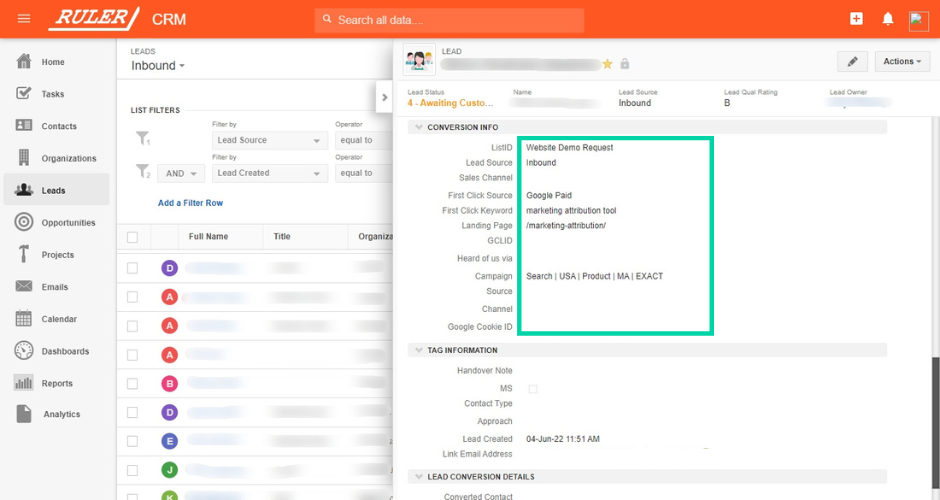
In addition to the expected contact details, we have added custom fields to capture Ruler’s attribution data. Using this data, we can see that this lead converted after completing a PPC search and viewing our marketing attribution product page.
Not only does this provide a single source of truth, but it also allows us to measure the impact of our marketing on later stages of the funnel.
As this lead moves through the pipeline, we can make better conclusions about our marketing performance and allocate budgets to campaigns that are expected to deliver the most revenue.
The final step is to visualise your multi-touch attribution data in a way that is easy to understand and interpret.
Data visualisation is important as it helps you identify patterns and trends in the data that might not be immediately apparent from looking at raw data.
Many marketers prefer to share and pass multi-touch attribution data into the tools they’re familiar with most.
For example, we feed multi-touch attribution data into Chartmogul. In ChartMogul, we’ve set up custom fields, and marketing source data is passed from our attribution solution and CRM. This allows us to see how much revenue we’re generating from each marketing channel every month.
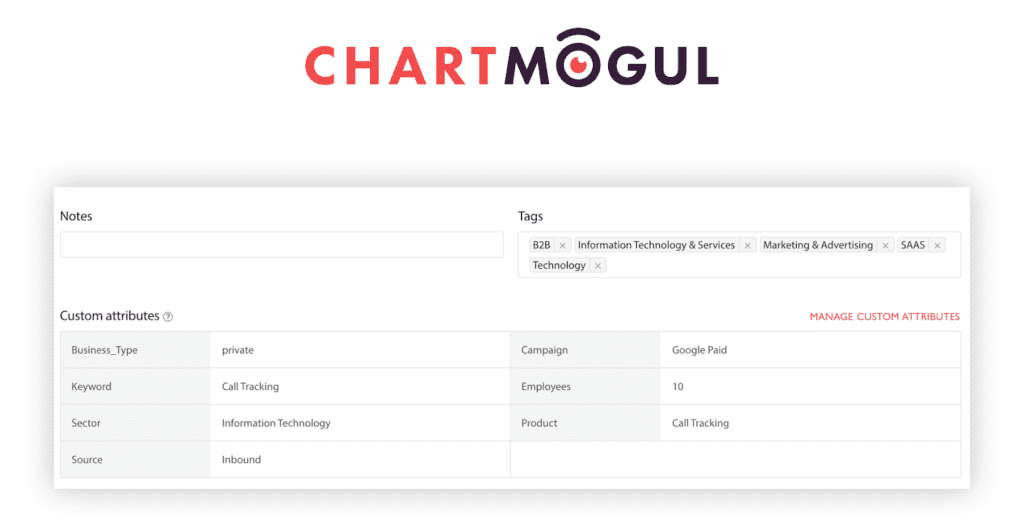
There are, however, a variety of data visualisation tools that you can use to turn your multi-touch attribution data into visually-appealing graphs, charts, and/or heat maps.
In recent years, multi-touch attribution has become less effective due to several factors:
While multi-touch attribution offers valuable insights, its mounting limitations have made alternative approaches like marketing mix modelling more appealing.
Unlike multi-touch attribution, that relies on click-path data and cookies, MMM uses historical data and statistical models to evaluate the impact of different marketing variables on business results, such as sales and ROI.
While MMM overcomes or is unaffected by many of the challenges of MTA, it is not without its own limitations:
Both multi-touch attribution and MMM serve as powerful tools for understanding the effectiveness of your marketing strategies, but neither is a standalone solution.
To obtain a more comprehensive and accurate view of marketing performance, it’s increasingly crucial to triangulate the truth by integrating MTA and MMM with self-reported data.
Multi-touch attribution can track your clicks and online touchpoints, while MMM can provide insights into offline marketing, ad impressions, and high-level budgeting and planning data.
Self-reported data, on the other hand, can offer qualitative insights into your dark social touchpoints that are not often captured by MTA or MMM.
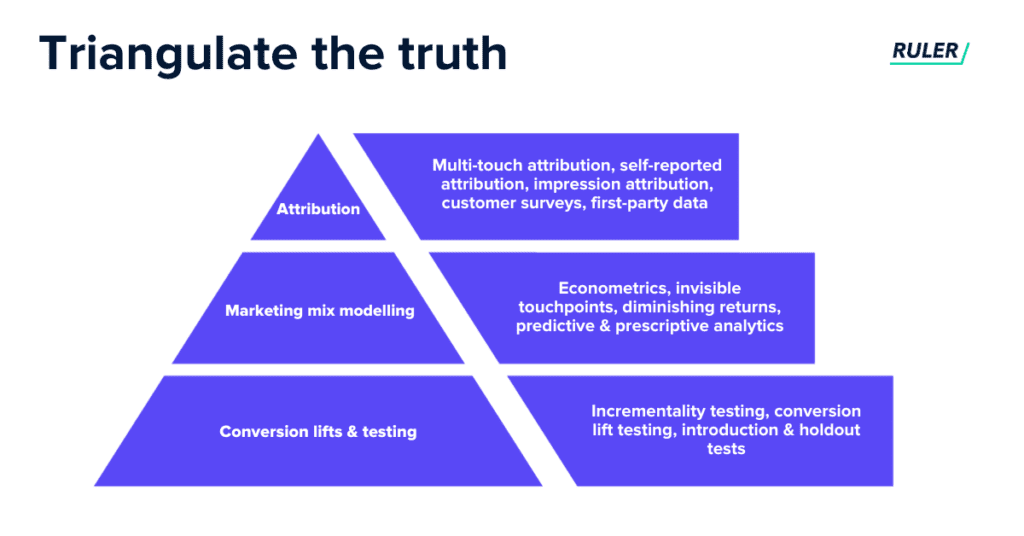
By using these methods together, you can get a more complete and nuanced understanding of your marketing performance, allowing you to make more informed decisions and allocate resources with more confidence.
Multi-touch attribution is vital to a successful marketing function.
But it’s even more powerful when it’s paired with marketing mix modeling. Multi-touch attribution and MMM gives you access to significantly more data to track effectiveness and ROI across all your channels—online and offline.
Once you have true multi-touch attribution and MMM capabilities, you’ll wonder how you went without it.
